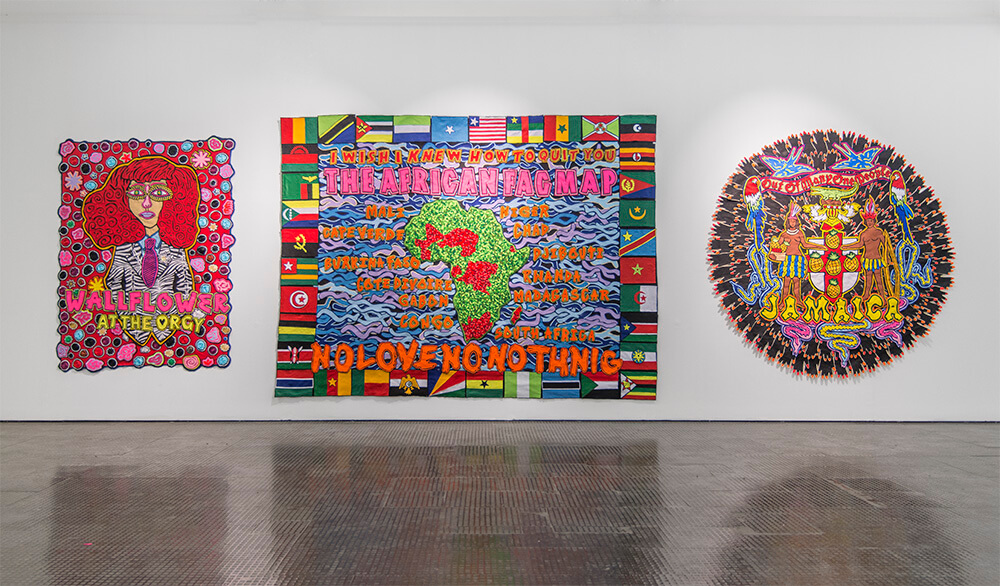Late Stage Capitalism Luxe
My initial impression of Pushing Thirty was that it must have made more sense at the opening, when peopled and noisy – the possibility of conversation and revelrie a balm for the show’s technicolour sensory overload.

Jody Paulsen | Pushing Thirty | Installation View
You could Instagram the fuck out of Paulsen’s show. But in person, it loses some of its dynamism – the same way that a meme might make sense on the screen of your cellphone but once it finds itself in a gallery space the culturally specific language; the much-reproduced, archetypal reaction images are imbued with too much seriousness, the extent to which the lightness of the whole thing collapses. Paulsen’s enormous felt collages that line the walls of the gallery with barely a space between them, work best at a glance; in a selfie; on a screen. In the silence of the show post-opening (and this is less the fault of Paulsen, or SMAC, but of the white cube model itself) Pushing Thirty is forced into the uncomfortable position of having to occupy the contemplative, weighty space expected of a solo gallery show.

Jody Paulsen | The Singleton Years (Yellow) | 2016 | Felt Collage | 187 x 171 cm
In spite of this, I do not think that the work – which draws heavily on this generation-specific lexicon – falls completely flat. There’s a lot to be said for Paulsen’s actual individual collages: enormous personal-memes-turned-art-objects. In his review of the exhibition, Lloyd Pollak describes Paulsen as someone with “no gift for words”, but as a fellow millennial, I can recognise that the flippant, colloquial (and distinctly contemporary) language that he uses is not clumsy, but part of the poetry of this lexicon.
The glib, jaded self-reflexivity present in Paulsen’s language is essentially the same as that which might crop up on one’s Instagram feed daily, and it is a language that has been developed in the crucible of the internet and social media, with the capability of conveying complex ideas through the film of an assumed shared cultural understanding. With Pushing Thirty – the exhibition’s namesake – the words “watching Netflix / mainlining Afghan kush” stretch out above a slight variation on the opening line of Macy Gray’s I Try: “games changes fears”, embodying with such exactness a “that feeling when” – that feeling when you’re too blazed to work, or when the lights come on at Club Med and you’re not done singing your final karaoke ballad.

Jody Paulsen | Pushing Thirty | 2016 | Felt Collage | 280 x 304cm
The symbols, logos and brand names that Paulsen uses are the hieroglyphs of this vocabulary. The more clear-cut queer symbolism of the ubiquitous pink flamingo, or the racial connotations of the Oreo logo aside, there is reference to a particular contemporary mythology that has been developed in relation with knock-off Versace at the Grand Parade, or the early-2000s street fashion propensity for retro band merchandise. It is not this post-postmodern engagement with commodity culture that is exciting, necessarily, but the temporal specificity of that engagement. One has a sense, with Paulsen’s work, that because of this, it’ll date badly – but that’s part of its charm. Paulsen manages to be keenly observant, and in some ways critical of contemporary consumerism without any hint of a Banksy-esque moral high-ground, and with little concern about how the work might age and ossify within the canon.

Jody Paulsen | Future Lovers | 2017 | 40 Felt Shirts and Ties | 187 x 237 cm
And Paulsen does deal with morality: in The African Fag Map, he highlights states in which homosexuality is illegal, and this work is accompanied by a number of other collages dealing either directly with these homophobic countries – Uganda is one example – or indirectly with the politics of Paulsen’s own identity as a gay man of colour. However, the position that he takes towards such weighted social issues as homophobia is decidedly light-hearted. This insouciant and playful approach to even his most serious subject matter does not diminish it, in my opinion, but serves to add nuance; to complicate and begin to reckon with these issues in such a way that that is simultaneously self-reflexive, cavalier and sharply socially aware.

Jody Paulsen | Uganda You Got To Be Kidding Me | 2016 | Felt Collage |185 x 169 cm
This multifaceted approach to contemporary identity politics, as well as the mythology used in the approach, seems to have flown almost entirely over Lloyd Pollak’s head. Although flippant, Paulsen’s engagement with a collective “millennial” identity, and with his own specific identity, is all processed and regurgitated through the symbolic language – that of late stage capitalism – which is most familiar to young people. These brand names, logos, and symbols of commodity culture are less frivolous than they may be read to be, as they are – not only in Paulsen’s work, but inside of a generational understanding of their symbolism – signifiers of a much larger culture of meta-ironic, concurrently self-aggrandising and self-deprecating aspirations for leisure and luxury in the context of an increasingly unstable social, political landscape